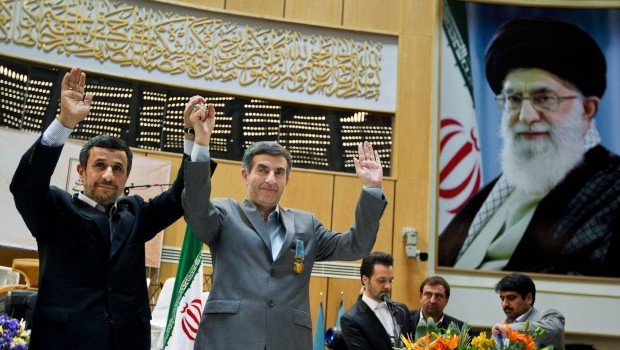On Tuesday, Iran’s presidential election was kick started, with would-be candidates beginning to register at the start of a 40-day sprint to polling day. By all accounts, the Tehran leadership is nervous about the whole exercise. On the eve of registration, Supreme Leader Ali Khamenei gave a curtain-raising speech, urging the people to “create a historic epic.”
Reading between the lines, Khamenei is calling for a massive turnout, bigger than in 2009, to show that the regime maintains momentum. In 2009, the authorities claimed that over 40 million people had voted. Khamenei did not mention his ideal figure. But President Mahmoud Ahmadinejad, who is not allowed to stand for a third term, has said that the ideal would be “100% participation.”
The first figure to bear in mind in connection with the coming election is 55 million—the number eligible voters.
The regime is determined to show that the election is inspiring as much enthusiasm as ever. This leads us to the second figure, cited by the daily Kayhan newspaper: thousands of people seeking to register as candidates. On Tuesday, Kayhan—published under Khamenei’s supervision—reported long queues at registration offices.
The third figure, the number of approved candidates, will not be known until three weeks before polling day.
Here there are two views. One is that the supreme leader wants a large number of candidates to avoid the kind of confrontation seen in 2009 when two men, Ahmadinejad and former prime minister Mir-Hossein Moussavi, dominated the process from the start.
Another goal, however, may be to wrap the whole thing up in one round, avoiding tension spread over weeks. Former foreign minister Ali-Akbar Velayati, a potential candidate, has argued in favor of that tactic. He said: “It would be preferable to have a candidate who wins straightaway,” adding, “this leaves no room for bickering and bitterness.”
That view ignores the fact that the Khomeinist establishment is currently divided into at least four factions, each of which would like to put forward a candidate.
Elections in Iran are not like normal elections in countries with a genuine pluralist system.
Iranian elections resemble the primaries of political parties in the United States. Though not organised as a party, the Khomeinist establishment is a single ideological bloc divided into different tendencies.
One faction is led by Khamenei, with a support base in the Islamic Revolutionary Guard Corps (IRGC) and the security services, the network of mullahs paid by government, and a portion of population benefiting from the various “foundations” that dominate segments of the economy.
The second faction’s father figure is former President Hashemi Rafsanjani. It includes former officials, technocrats, businessmen and sections of the urban middle classes wary of Ahmadinejad’s populism.
The third faction has Ahmadinejad as standard-bearer, with Esfandiar Mashaei as chief strategist. That faction is backed by part of the civil service, elements in the IRGC, and those mullahs who regard Khamenei as a usurper.
The fourth faction consists of dissidents who profess loyalty to Khomeinism as an ideology, but accuse Khamenei of establishing a despotic system with support from the military and security apparatus. Because they cannot operate openly, even within the limits set by the regime, it is difficult to gauge the extent of the support such dissidents might have within the establishment. The fact that this faction’s two key leaders, Moussavi and former Majlis speaker Mehdi Karroubi, are under house arrest makes it difficult to estimate its weight.
The rules set for the election exclude many who might have been able to stand under normal circumstances. The entire opposition, ranging from Communists to monarchists and passing by nationalists and liberals, are branded as “enemies” and thus are excluded.
Rules published by the Ministry of the Interior, which is responsible for organizing the election, spell out other exclusions.
Half of the population—women—are barred from the start: only men can apply as candidates. Although legally recognized as religious minorities, Christians, Jews and Zoroastrians—altogether numbering around one million—are also excluded. In addition to this, Bahá’is, an illegal religious minority believed to number over 300,000, are also excluded.
However, just being Muslim is not enough for candidacy. Iranian Sunni Muslims, believed to number around 12 million, are also excluded.
“The would-be candidates must be Shi’ite Muslims,” the ministry declares.
Even then, not all brands of Shi’ism are accepted. The Seveners (Ismailis) are excluded, as are Zaidis, not to mention smaller, esoteric offshoots of Shi’ism.
However, being a Twelver (Ithna’ashari) is not enough, either. The candidate must be “a political or religious” figure. This means that others—for example a businessman, an opera singer or a taxi driver—cannot seek the presidency.
Another condition is that the candidate should “believe in” and be ”loyal” to the system in place. But what if a candidate wanted to stand on a platform of radical reform, for example by abolishing velayat-e faqih (guardianship of the jurist) while maintaining the Islamic Republic in its basic structure?
The ministry’s statement sets other problematic conditions. It states that a candidate must be of “Iranian origin”. What does that mean? Under Iranian law, anyone born in Iran automatically becomes Iranian regardless of the origins of their parents or ancestors. At the same time, anyone born outside of Iran to at least one Iranian parent can also demand Iranian citizenship.
The published rules include other oddities. The candidate must be “pious and trustworthy” and have “a good record.” He must also offer “managerial skills” and be “careful.” But how could we find out if someone fulfills such subjective conditions?
Clearly, such conditions would give the authorities ample opportunity for blocking the candidacy of figures regarded as a threat to Khamenei.
This is not about electing a president in the normal sense of the term. It is about choosing a “yes-man” for the supreme leader. Are the Iranians still interested in this? We shall know on polling day.
